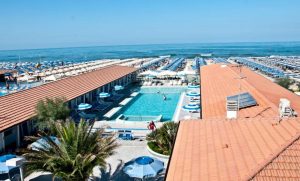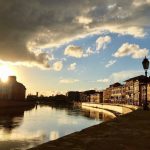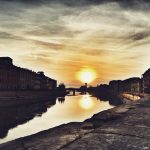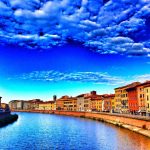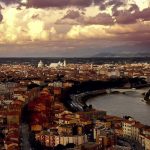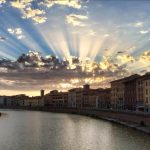PIAZZA DEI MIRACOLI
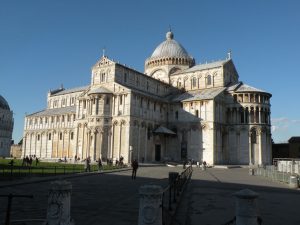
The square of the Duomo of Pisa – dominated by the Cathedral, the Baptistery, the Bell Tower and Graveyard (the Campo Santo) – represents an architectural whole characterized by a really surprising stylistic accordance, to the point of having been compared by Le Corbousier to the acropolis of Athens. The choice of materials, with an almost absolute supermacy of the white marble, and the constant presence of blind arches at the base and practicable small loggias in the upper orders lead to the thought of single project, almost the expression of the group of artists that works well together in the same building site in a relatively short lapse of time. Still, this is the result of long process that saw various architects, sculptors and painters taking turns, in the space of more than three centuries, and amongthem some leading personalities who have marked their epoch.
The Knights’ Square (Italian: Piazza dei Cavalieri) is a landmark in Pisa, Italy, and the second main square of the city. This square was the political centre in medieval Pisa. After the middle of 16th century the square became the headquarters of the Order of the Knights of St. Stephen. Now it is a centre of education, being the main house of the Scuola Normale di Pisa, a higher learning institution part of the University. It is located at the same place as the forum of the antique Portus Pisanus, the harbor of Pisa in Roman age. The square, known as Square of the seven streets was the political heart of the city, where the Pisans used to discuss their problems or celebrate their victories. After 1140, the square become the center of Pisa Comune, with construction of buildings belonging to several municipalities and magistrates, as well as several churches. After the victory of the People of Pisa in 1254, the Palace of the People and the Elders was built on the square by joining some pre-existent buildings. The Captain of the People was housed in the near Clock Palace (since 1357), which incorporated some previous existing towers. The southern part of the square was rebuilt with offices, law courts and the residence of the Podestà.
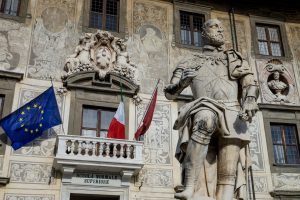
PISA CHARTERHOUSE
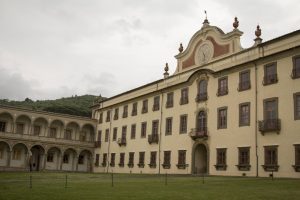
Pisa Charterhouse, also known as Calci Charterhouse (Certosa di Pisa, Certosa di Calci), is a former Carthusian monastery, or charterhouse, currently the home of the Museo di storia naturale e del territorio dell’Università di Pisa (“Museum of Natural History and of the Territory of the University of Pisa”), located in the comune of Calci, some 10 km outside Pisa, Tuscany, Italy.
The Carthusians founded a monastery in 1366/67 in what is called Val Graziosa, a plain overlooked by the Monti Pisani , when Francesco Moricotti Prignani was archbishop of Pisa. Shortly afterwards Pope Gregory XI, a noted reformer of monasteries, expelled the monks from the Benedictine Gorgona Abbey, on the island of Gorgona, and gave the island and the estate to the Carthusians of Val Graziosa, who repopulated them. This event must have happened not long before Catherine of Siena’s visit of 1375, as she mentions in her letters the need to convert the facilities for the Carthusian use. Benedictines were barred from the island.
The monastery is noted for the fresco of the Last Supper, by Bernardino Poccetti (1597), in the refectory.
The Carthusians founded a monastery in 1366/67 in what is called Val Graziosa, a plain overlooked by the Monti Pisani , when Francesco Moricotti Prignani was archbishop of Pisa. Shortly afterwards Pope Gregory XI, a noted reformer of monasteries, expelled the monks from the Benedictine Gorgona Abbey, on the island of Gorgona, and gave the island and the estate to the Carthusians of Val Graziosa, who repopulated them. This event must have happened not long before Catherine of Siena’s visit of 1375, as she mentions in her letters the need to convert the facilities for the Carthusian use. Benedictines were barred from the island.
The monastery is noted for the fresco of the Last Supper, by Bernardino Poccetti (1597), in the refectory.
Sant’Antonio is a route that starting from the center of the city, through the renewed Vittorio Emanuele square, continues with Keith Haring’s mural and the Domus Mazziniana. Then goes right along the Arno river who gives a little taste, then lead us in narrow alleys of the old town. Domus Mazziniana is the home where he spent the last years of his life and died on March 10, 1872, Giuseppe Mazzini. The building is located in Pisa via Mazzini 71 (also from Via d’Azeglio). The Domus Mazziniana is open to visitors and is one of the most beautiful historic residences in the city.
It was donated to the state by the Rosselli Nathan family and is currently run by the Fine Arts. The house was then located in the then Maddalena Street and was declared a national monument on April 20, 1910. The building was almost sunk to the ground during the bombing of Pisa of August 31, 1943, where original furniture was also destroyed, while the various memorabilia had already been saved by the staff of the Superintendence at Monuments.
It was donated to the state by the Rosselli Nathan family and is currently run by the Fine Arts. The house was then located in the then Maddalena Street and was declared a national monument on April 20, 1910. The building was almost sunk to the ground during the bombing of Pisa of August 31, 1943, where original furniture was also destroyed, while the various memorabilia had already been saved by the staff of the Superintendence at Monuments.
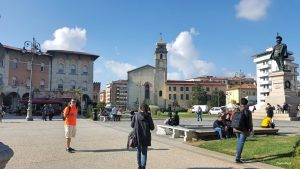
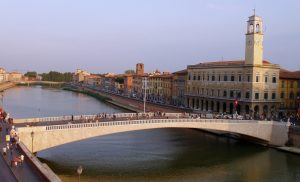
Many poets and artists have been fascinated by Lungarni Pisani having inspiration from the beautiful noble palaces that overlook the Arno river. Today, this location also features important museums along the Arno river creating a real “museum system.” This is a picturesque walk which has as its theme the river has always been inextricably linked to the life of the city.
if you want to add a pinch of fun and relaxation to your cultural trip to Pisa you can go to one of the nearest beaches along the coast. Pisa is not far from the sea (remember that during its Golden Age, from the eleventh to the thirteenth centuries, the city was one of the maritime powers of the Mediterranean) and offers many different solutions.
